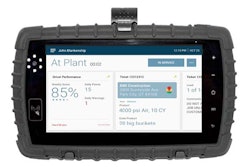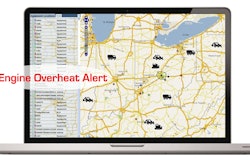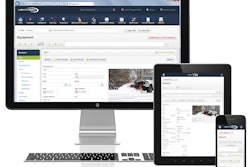During an economic downturn when the funds to purchase new equipment are scarce, it's important to be vigilant over your existing fleet. This includes deterring theft and optimizing maintenance. Fortunately, there are many fleet management tools available to help you do that.
We asked four leading system providers what a fleet management system can do for rental businesses and here's what they had to say:
Q: How can a fleet management system help rental businesses deter theft?
A: Mark Bittner, Topcon, developer of Topcon Tierra - "Topcon Tierra offers geofencing. It has a motion sensor with an internal battery backup that allows detection and reporting of unauthorized movement even when the machine is turned off or on a trailer. Users can locate a machine at the touch of a button. Tierra also offers a "curfew" feature which alerts managers of unauthorized machine use outside the normal hours of operation. There is also the Remote Anti-Start feature that prevents thieves from driving unattended machines."
A: Bob DeAngelis, Senior Director for LoJack's Commercial Division - "LoJack's "LoJack's Ruggedized Stolen Vehicle Recovery system for construction equipment is based on Radio Frequency (RF) technology. RF enables stolen equipment to be found - even if they are hidden in a steel container, a tunnel or concrete garage, in dense foliage or in a chop shop. The LoJack System is also directly integrated with police, who use Police Tracking Computers (PTCs) to find and recover stolen equipment. This real-time communication delivers unprecedented precision in tracking and recovery. Since entering the construction market in 2000, the company has recovered more than $100 million in LoJack-equipped stolen construction assets-plus the value of other stolen non-LoJack equipped construction equipment police recovered in chop shops and theft rings."
A: Tony Nicoletti, DPL America, developer of the Titan Equipment Monitoring System - "We have multiple layers of theft protection: Rental houses can locate an asset in real time, anytime from any Internet-connected device (computer, Blackberry, iPhone, etc.). We offer a 'homing beacon' function that sends out a new location automatically every two minutes, which creates a trail on the map for the police to follow in the instance of theft. The Titan also has geofence (invisible boundary) alarms as well as a customer-defined curfew for unauthorized use or movement, which immediately contacts the owner's cell phone. Rental houses are also empowered to remotely disable any machine from starting if it is to be stolen."
A: Sean Taylor, director of sales for Collective Data - "collectiveFleet's fuel module allows a company to monitor fuel usage and minimize theft from misuse of fuel cards. Inventory control is also available to track and maintain the parts inventory, helping to eliminate theft or core charge fraud."
Q: How can a fleet management system streamline maintenance of heavy equipment?
A: Tony Nicoletti, DPL America, developer of the Titan Equipment Monitoring System - "One major benefit rental owners experience [with our system] is a decrease in service costs and an extension in the productive life of the machine. It goes without saying that an automated hour meter collection system will reduce the time and errors associated with manually collecting those readings and inputting them into electronic format. The Titan tracks PM schedules and provides an automated 'service due' notification based on those remotely collected hours, and also provides an upcoming schedule of service based on these readings, color-coding a machine in the software depending on how far out from the next maintenance it is.
"Additionally, with GPS a driver or dispatcher can locate an asset's exact location on a job for pickup or service, thus reducing wasted time spent searching for the piece. The Titan also monitors machine health and sends a proactive, wireless alarm as an email or cell phone text message if a condition on the equipment becomes threatening."
A: Jeremy Warnick, LoJack Corp., developer of LoCate by LoJack - "LoCate by LoJack's Engine Hours function provides users with daily engine hours usage data for more effective maintenance planning, which can extend the life of equipment and helps avoid downtime due to engine failure. The system's reporting functionality creates user-defined reports to track equipment utilization and maintenance scheduling. It allows users to analyze fleet and workforce productivity, maximize equipment utilization, and get accurate, timely data to support key decisions regarding your fleet."
A: Sean Taylor, director of sales for Collective Data - "collectiveFleet allows the client to set up the maintenance schedule that fits their needs and situation. Flexibility and accountability are part of helping a fleet be as efficient as possible. With our collectiveFleet Solutions package, we can allow access to updating information with our Mobile Apps module, adding real-time connectivity from the field and the office. The technician can update the status of the work orders or meter reading through a standard web browser. Operators can also make maintenance requests through the Mobile Apps module, alerting the maintenance staff of issues with the vehicles they are operating. Indentifying problems in their early stages saves money on unnecessary repairs due to further damage."
A: Mark Bittner, Topcon, developer of Topcon Tierra - "Tierra replaces all the manual data collection that often just doesn't get done. It automatically monitors engine hours, sends an alert when maintenance is due, and provides an audit trail to let equipment owners know if the maintenance was done or not. This has a direct impact on uptime and warranty. By alerting owners to how much equipment is standing idle, Tierra can help reduce idle time by 10 percent, which can translate into hundreds of thousands of dollars every year. In this way, the system pays for itself in months.


















